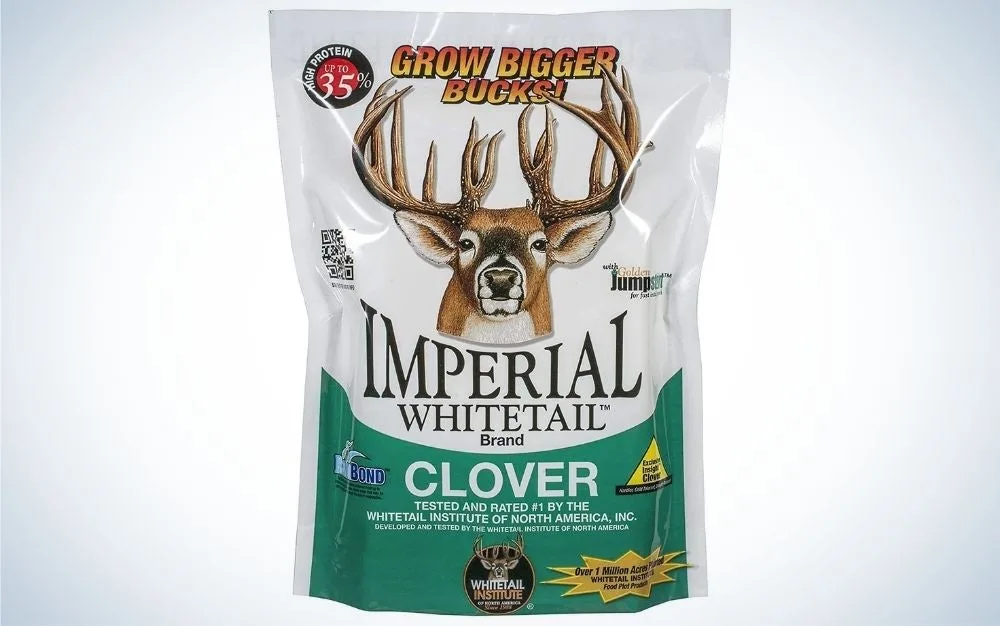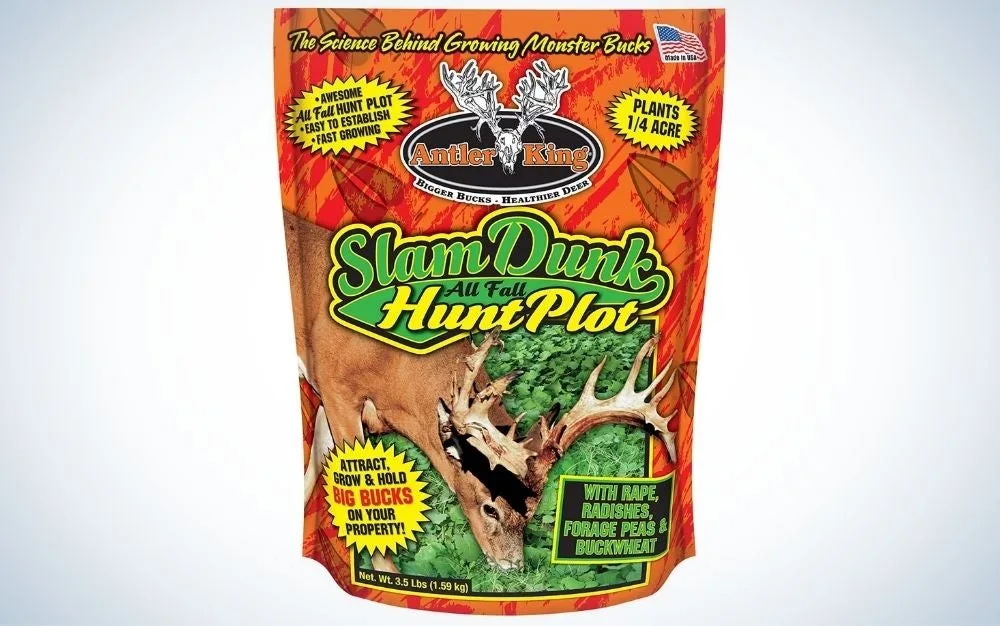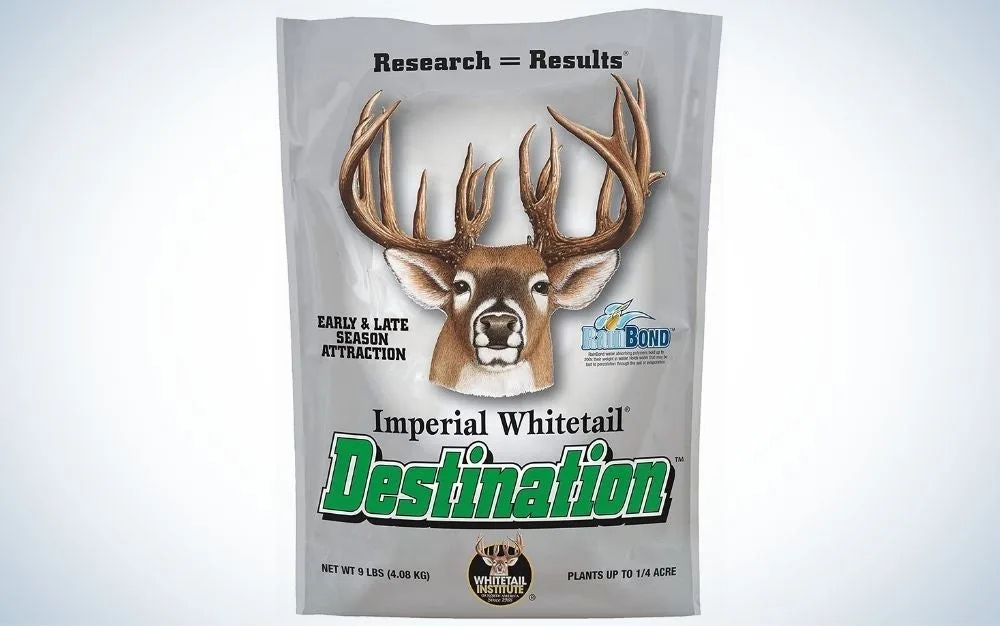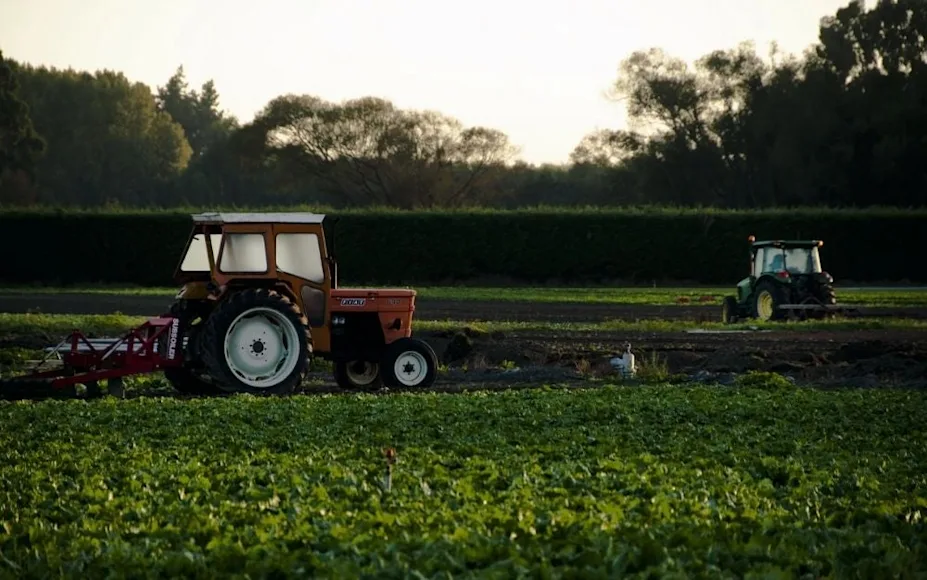_We may earn revenue from the products available on this page and participate in affiliate programs. Learn more ›
_
Best Overall

Whitetail Institute Imperial Whitetail Clover
LEARN MORE
Summary
Imperial Whitetail Clover is a mixture of proprietary ladino clovers that can be used in wooded settings if the spot receives five hours or more of sunlight.
Best for Fall

Plant Biologic Maximum
LEARN MORE
Summary
Maximum includes eight different plants and can produce up to an incredible 10 tons of forage per acre.
Best for Shaded Woods

Antler King Slam Dunk
LEARN MORE
Summary
lam Dunk Includes a variety of seeds that will grow with little soil preparation, making it great for no-till planting in small woods clearings close to deer bedding areas where a tractor can’t reach and where minimal disturbance is best.
Food plots are the only forage grown specifically to feed deer. Sure, whitetails will eat farmers’ crops, fruits in orchards, and suburban gardeners’ flowers. But only food plots are parcels of ground planted with great forages
intended to draw in deer.
Besides attracting deer, food plots planted with the best seeds offer protein, carbohydrates, vitamins, minerals, and energy to whitetails—nutrition that means healthier does and bucks with bigger racks. Food plot prep is an absorbing pastime in itself—preparing the ground, planting, and watching the tiny seed you sowed grow into large plants that will nourish deer and entice them to stay on your land. And with the popularity of food plotting today, chances are if you don’t offer a quality plot grown with the best seed available, your neighbor will. And that’s where the deer will go.
Below is an assortment of the best food plots for deer for a variety of regions and habitats. Use this guide to select what’s best for your area, and draw deer to your favorite hunting spot.
Best Overall: Whitetail Institute Imperial Whitetail Clover
Best for Fall: Plant Biologic Maximum
Best Spring and Summer Annual: Whitetail Institute Power Plant
Best for Shaded Woods: Antler King Slam Dunk
Best for Deer in Winter: Plant Biologic Green Patch Plus
Best for the South: Imperial Whitetail Destination
How We Picked the Best Food Plots
We defined food plot seeds as forages grown with the dual purposes of both attracting and providing nutrition to deer and other wildlife. In analyzing the hundreds of choices available to sportsmen and wildlife aficionados, I rated plots on these qualities:
Palatability or taste appeal: How desirable do deer find this forage?
Rapid establishment: How quickly does this seed grow?
Resistance to feeding pressure: Do these crops stand up to heavy browsing?
Ability to grow in poor soils: Can these seeds thrive in sub-optimal soil conditions?
Reasonable cost: Do these seeds produce a good crop without costing an arm and a leg?
Ease of growing: Do you need a Green Thumb to produce a workable food plot?
Digestibility: Can deer easily digest this crop?
Length of time available to deer: How long is the crop’s growing season?
Drought hardiness: Can these crops stand up to low-water conditions?
Benefits to soil: Do these plants provide the soil with nitrogen or other useful elements?
Protein content: Does the forage produced by this mix provide ample protein to deer?
Most food plot seeds today are high quality, but the selections chosen here stood out above the rest on a number of these factors.
Best Food Plots: Reviews and Recommendations
Best Overall: Whitetail Institute Imperial Whitetail Clover
Best Overall

Specs
Seed Type: Perennial white clovers
Seeding Rate: 4-pound bag plants up to ½-acre
Planting Time: Spring or early fall
Pros
Extremely palatable to deer
Produces forage 10 months a year in northern states and Canada, 12 months in southern locations
Benefits the soil by supplying its own nitrogen needs and deposits surplus nitrogen in the ground for future crops
Withstands heavy browsing pressure by deer and keeps producing new forage, lasting 3-5 years before requiring replanting
Cons
Costlier than many food plot seeds
Can require mowing or treating with a selective herbicide if unwanted grasses invade the plot
Imperial Whitetail Clover is a mixture of proprietary ladino clovers that can be used in wooded settings if the spot receives five hours or more of sunlight. Most often, it is planted in larger fields to attract deer to the property and provide them high-quality nutrition. These plants fill in any bare spots in the plot with stolons, runners or stems that spread above ground and re-root themselves, creating new plants. Unlike some food plot forages, deer cannot destroy Imperial Whitetail Clover by over-browsing.
Best for Fall: Plant Biologic Maximum

Best for Fall

Specs
Seed Type: Annual brassicas
Seeding Rate: 9 pounds cover one acre
Planting Time: Late summer in northern states, early fall south
Pros
Easy to establish
Exceptional protein level
Stands tall above snow when many lower-growing forages like clover are buried
High tonnage
Cons
May take a while (up to a season) for deer to get used to feeding on this new food
While the Whitetail Institute was developing Imperial Whitetail Clover, Mossy Oak’s Plant Biologic arm went to New Zealand to obtain its feature forage—the best brassica plants used there to produce maximum weight and antler growth in captive herds. Brassicas such as rape, kale, and turnips along with daikon radishes outcompete weeds and suppress them with glucosinolates they secrete. The brassicas also break up and aerate compacted soil and draw nutrients from deep levels, depositing them in shallower depths for future plantings. These plants are especially useful in northern states where they grow above the snow when clovers and alfalfas are buried.
After the first frost, starches in these plants are converted to sugars, then drawn up from the roots and deposited in the leaves, making them even more attractive to deer. Maximum provides vital energy and carbohydrates that are crucial to does and bucks as they approach the challenging winter period.
Best Spring and Summer Annual: Whitetail Institute Power Plant
Best Spring and Summer Annual

Specs
Ingredients: Cowpeas, sunn hemp, sunflowers, forage soybeans
Seeding Rate: 25 pounds plants up to 1 acre
Planting Time: April-July
Pros
Thrives in drought conditions
Withstands grazing pressure because of protective nurse crops
Also serves as bedding cover
Cons
Doesn’t do well planted in plots less than two acres, deer will often destroy it
Cannot be treated with Roundup or glyphosate to control weeds, but grasses can be eliminated with Arrest Max herbicide
Power Plant is a mixture of two specially selected legumes, cowpeas and forage soybeans, that grow rapidly, attract deer and provide high-quality nutrition. Two other plants, sunflowers, and sunn hemp offer stalks the vining-type beans and peas can climb. The soybeans included offer more tender leaves and less stem than agricultural soybeans, making them more attractive and palatable to deer.
They also bounce back strongly when deer feed on them, growing new leaves. The sun hemp in the mix can also withstand heavy browsing and keep growing. This combination of plants grows so thick that deer often bed right in the food plot.
Best for Shaded Woods: Antler King Slam Dunk
Best for Shaded Woods

Specs
Ingredients: Buckwheat, forage peas, canola, radishes
Seeding Rate: 3.5 pounds plants ¼-acre
Planting Time: July-September
Pros
Easy to establish
Starts germinating in 3-5 days
The different plants attract deer from early fall through winter
Cons
Low to moderate protein levels
May struggle to grow if less than four hours of sunlight a day reach the plot
Slam Dunk is perfect for remote wooded settings. It contains plants that will thrive in soils with pH’s as low as 5.4 and shaded locations, making it great for natural clearings or logging roads. It includes early and late maturing plants that will attract deer during October bow hunts and January muzzleloader seasons. Forage peas and buckwheat attract deer early.
Radishes and canola entice them in the dead of winter, protruding above snows for easy feeding accessibility. The brassicas also draw up phosphorus and calcium from deep in the ground, depositing them at higher levels where clover and other shallow-rooted forages can benefit from them for future plantings.
Best for Deer in Winter: Plant Biologic Green Patch Plus
Best for Deer in Winter
Specs
Ingredients: Brassicas, clover, wheat
Seeding Rate: 40 pounds plants one acre
Planting Time: Fall, 30 days before frost
Pros
Economical
Easy to plant, just spread before a rain
Wheat bounces back after being eaten down
Cons
Requires lots of seed per acre
Green Patch Plus offers deer 36 percent protein levels providing crucial nutrition during fall and winter, with 80 percent total digestible nutrients. Apply 19-19-19 fertilizer or follow specific recommendations provided by a soil test
and simply spread out the seed before rain or lightly cultipack it. Plants will appear within days; first wheat and clovers, then brassicas.
The wheat will draw deer early, and provide forage that regenerates and grows back if deer eat down the brassicas. This cereal grain is very cold-hardy and can offer forage right through late winter into early spring, a nutritionally challenging time for whitetails.
Best for the South: Imperial Whitetail Destination
Best for the South

Specs
Ingredients: Oats, winter peas, clover, kale, and radish
Seeding Rate: 9 pounds plants ¼-acre
Planting Time: September-October
Pros
High palatability
Appeals to animals for a long period through fall and winter
Easy to grow
Improves soil tilth by aerating compacted ground
Cons
Peas may be destroyed by deer
Destination will become exactly that for deer on your land with the precisely-mixed combination of forages included in this product. Five annuals are combined to offer food for deer from early fall through winter. Since they are all annuals, no maintenance is required for a perfect plot.
In early fall Whitetail Oats are the main attraction, along with Alex Berseem, a fast-growing clover that “jump starts” the plot and draws deer in quickly. The oats were part of an agricultural study aimed at finding a cereal grain to grow for livestock. That study was halted because the oat involved drew too much pressure from deer. The Whitetail Institute bought the exclusive rights to the grain for hunters.
The unique winter peas included offer higher sugar content than most peas. Later in the fall, the company’s exclusive kale and radish offerings come on strong, with the radishes also producing improvements in soil tilth, aerating compacted dirt, and drawing nutrients up from deep levels, and leaving them where they are available for future plantings on the site.
What to Consider When Choosing Food Plots
Natural foods growing in the wild make up the bulk of a whitetail’s diet, but many of those native foods are low in protein and available for only short periods in their most nutritious phase. Acorns, for instance, offer a few weeks of food in the fall, but there are bad years when the woods only provide poor mast crops. Even when acorns are abundant, they offer little protein, and some taste bitter.
The best food plot plantings have high taste appeal (palatability) and offer protein in the 25-40 percent range. And they last for months rather than weeks. By planting different varieties of seeds, you can offer deer food for 12 months of the year, encouraging them to stay on the property year-round. But to pick the perfect seed mix for your area, you need to take some things into consideration.
The Lay of the Land
The key to success with food plots is knowing what your needs are. The person who has 30 or 40 acres available for plots will have different requirements than the average hunter who maybe wants to put in an acre or two of plots scattered around a smaller tract of land.
Another consideration is what local farmers grow. If you are surrounded by farmers who grow soybeans or corn, you clearly don’t want to plant those forages. Chances are the farmer will produce better crops and there will be nothing unique to draw deer to your land.
Having time free to maintain the plot is also important. Some plants, mostly annuals, are virtually maintenance-free. Perennials on the other hand require occasional mowing and sometimes weed and grass control by spraying with selective herbicides.
A Question of Timing
There are food plots for spring and summer and others best for fall and winter. Make sure you choose the right variety for the time you are planting.
Determine your priorities and time constraints, then select the ones that suit your needs and the property’s size and layout. Of course, no seed mixture will excel in all of these properties. The importance of the factors will vary according to how you plan to use the plot as well as its size and location.
Variety
When possible, choose several varieties from these seed choices and plant them at different locations on the property. As much as deer crave nutrition and tasty foods, they also like variety. Some deer may have different taste preferences from other deer. The landowner who has a variety of different forages will likely have something that appeals to almost any deer’s taste buds. Also make sure you have food plots that are available throughout the year.
FAQs
Q: What is the best thing to plant for deer?
Clover such as Imperial Whitetail Clover is probably the single best food plot seed, but there are many others that serve important roles for the food plotter. Brassicas are a strong second choice, such as Plant Biologic’s Maximum.
Q: How big should a food plot be for deer?
It depends on the habitat and how much land you own. Some quarter-acre plots tucked away in the woods near (but not too close) to bedding cover can produce great hunting. But plots of one to five acres will do more to attract large numbers of deer and provide them nutrition.
Q: What is the best late season food plot?
Brassicas are excellent because they stand up tall above the snow and grow sweeter after the first frosts convert starches inside them to sugars, appealing to deer even more. Good second choices are wheat and oats which will regrow as deer feed on them and last through winter into early spring.
Q: When should I start a deer food plot?
Spring is a good time, but you will have to contend with more weeds in the plot as it comes up. Fall is perhaps best because you can have more time to eradicate all the weeds and grasses during the summer before planting and have the plot come up strong for hunting seasons. Fall plots are planted between August and early October, depending on the seed type.
Q: What is the easiest food plot to grow?
Rye, but it’s not particularly valuable for the deer. Wheat is better, and just about as easy to grow. It’s included in several of the recommended seed selections here.
Best Food Plots: Final Thoughts
Best Overall: Whitetail Institute Imperial Whitetail Clover
Best for Fall: Plant Biologic Maximum
Best Spring and Summer Annual: Whitetail Institute Power Plant
Best for Shaded Woods: Antler King Slam Dunk
Best for Deer in Winter: Plant Biologic Green Patch Plus
Best for the South: Imperial Whitetail Destination
Growing food plots for many becomes a passion as strong and deep as hunting. The time spent choosing seed, preparing the plot, then planting and maintaining it, becomes a labor of love that many enjoy as much as eagerly heading out for the first bow and muzzleloader seasons. To get the best food plots possible, you simply cannot surpass the results you’ll obtain from planting Imperial Whitetail Clover, one of the first food plot seed blends developed. It grows strongly in a wide variety of soils, produces extremely palatable forage for deer 10-12 months a year, and stands out distinctly to whitetails as something different—and more nourishing—than the endless acres of soybeans and corn found in surrounding farm fields or the bitter-tasting acorns only available for a few weeks each fall.
Why Trust Us
For more than 125 years, Field & Stream has been providing readers with honest and authentic coverage of outdoor gear. Our writers and editors eat, sleep, and breathe the outdoors, and that passion comes through in our product reviews. You can count on F&S to keep you up to date on the best new gear. And when we write about a product—whether it’s a bass lure or a backpack—we cover the good and the bad, so you know exactly what to expect before you decide to make a purchase.






